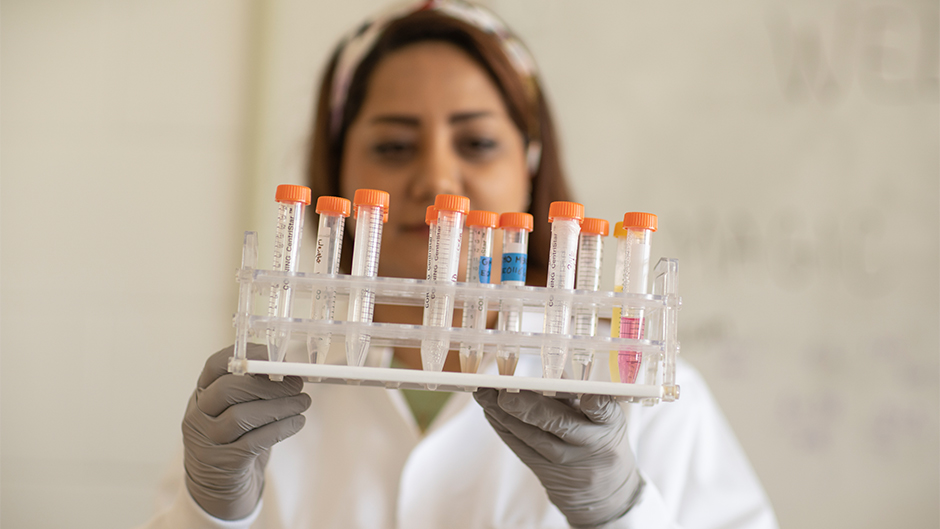A team of University of Miami researchers has been awarded a National Science Foundation (NSF) grant to study how intelligent materials in form of multifunctional nanoparticles can activate brain circuitry, laying a foundation for potential new therapies for neurodegenerative diseases, cancerous tumors, and other disorders as well as helping shed light on the computing architecture of the brain.
“We will be using intelligent materials, particularly magnetoelectric nanoparticles (MENPs), that can respond to wireless signals and simultaneously deliver different types of energy to the brain on a micro level,” said Sakhrat Khizroev, Ph.D., professor of electrical and computer engineering at the College of Engineering. “This innovative project can also advance brain-machine-interface (BMI) technologies by connecting neurons to bioengineered devices and artificial intelligence (AI) applications through a noninvasive link with unprecedented high spatial and temporal resolutions.”

Sakhrat Khizroev, Ph.D., professor of electrical and computer engineering at the College of Engineering
Khizroev is the principal investigator (PI) for the collaborative study, “Magnetoelectric Nanoparticles As Multi-Field Controlled Devices for Activation of Brain Circuitry,” funded by a three-year, $500,000 NSF grant. Other principal investigators are Michael R. Wang, Ph.D., professor of electrical engineering at the College of Engineering, Brian Noga, Ph.D., professor of neuroscience at the Miami Project to Cure Paralysis at UM, and Ping Liang, Ph.D., professor emeritus of electrical engineering at the University of California, Riverside, and CTO of Cellular Nanomed, Inc. (CNMI), a tech start-up with the goal of creating MENPs and other intelligent materials and nanodevices for various biomedical applications.
Deadly brain diseases, such as glioblastomas or other cancerous tumors, as well as neurodegenerative conditions like Alzheimer’s disease are difficult to treat because the brain-blood barrier limits the impact of medications, Khizroev said. “But MENPs could potentially deliver drugs, thermal, radiofrequency, or ultrasound therapies directly to local areas at the cellular or sub-cellular level,” he added.
MENPs belong to a class of intelligent materials. These nanostructures respond to external stimuli in a specific way, changing their physical properties at the molecular level. Furthermore, unlike any other nanostructures known to date, MENPs equally respond to multiple fields such as electric, magnetic, acoustic, and electromagnetic waves such as near-infrared light. As a result, when placed in biological microenvironments, MENPs serve as nanoscale hubs which allow to locally collect energies carried by multiple fields and then distribute the combined energy back into the biological microenvironment according to a desired algorithm to trigger a target biological sequence. First proposed by Dr. Liang, this multimodal field approach allows to combine strengths of different fields while mitigating their weaknesses.
This is all performed at the molecular level due to the complex quantum physics of these nanoparticles at the nanoscale. In turn, due to the sophisticated control, a very broad spectrum of fields can be controlled at the target site to achieve communication between the brain and the computer. For example, multimodal strategy will allow Miami Engineering researchers to get real-time inputs into neural activity, deliver different types of energy to highly localized regions of the brain and, reciprocally, read back the neural activity, thus shedding light on the computing architecture of the human brain, which still remains a mystery.
“By providing a combination of remotely controlled magnetic fields, focused ultrasound (FUS) waves or near-infrared (NIR) light, our nanoparticles will generate high-resolution patterns of local electric field,” said Liang. The magnetic fields will be used to deliver most of the energy required to stimulate neurons, while the FUS wave or NIR light will define local stimulation regions with spatial resolution in the sub-millimeter range.
“This multi-field approach allows us to study the required energy, spatial resolution, and tissue penetration for different types of therapies and identify the most effective results,” Khizroev said. The researchers will also use hippocampus neuronal cell cultures in the laboratory to understand the interactions of the multimodal effects through high-resolution imaging.
A wireless brain-computer interface
A second goal of the NSF grant is to use MENPs and wireless technology to build a wireless brain-computer interface and allow today’s neural computing networks to learn quickly and easily from human processes.
“According to the Principle of Reciprocity, by wirelessly activating neurons–writing information–deep in the brain, our project could pave a way also to record neural activation–the ability to read back that information at the single-neuron level in real time,” said Khizroev. “This would be a major step forward in understanding the brain computing architecture, which could revolutionize information processing and creation of artificial intelligence.”
Along with these two areas of focus, the NSF-funded project will include a special STEM program to target minority college students and an outreach program to K-12 students. It will also propose a new interdisciplinary Ph.D. degree program in brain engineering to meet the increased demand for experts in the emerging field. “We want to provide more opportunities for underrepresented students to participate in this exciting research and learn about STEM careers in this field,” Khizroev added.
Khizroev and Liang have developed MENPs for a wide range of medical applications, including wireless brain-machine interface, targeted drug delivery, and high-specificity cancer treatment. They are co-founders of CNMI, which received a multi-million dollar “Next-Generation Non-Surgical Neurotechnology (N3) for Brain-Computer Interface” research contract from the Defense Advanced Research Projects Agency of the United States Department of Defense.

